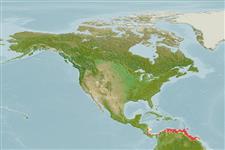>
Acropomatiformes (Oceanic basses) >
Synagropidae (Splitfin ocean-basses)
Etymology: Caraibops: Name from 'caraib', a collective name for the Indian tribes formerly inhabiting the Caribbean basin, combined with the ending -ops for the similar sounding to the related genus Parascombrops..
Environment: milieu / climate zone / depth range / distribution range
Ecología
marino batidemersal; rango de profundidad 36 - 550 m (Ref. 9626). Deep-water; 13°N - 6°N
Western Atlantic: from NE Gulf fof Mexico to Suriname.
Tamaño / Peso / Age
Maturity: Lm ? range ? - ? cm
Max length : 11.5 cm TL macho / no sexado; (Ref. 9626)
Espinas dorsales (total): 8 - 9; Radios blandos dorsales (total): 10; Espinas anales 3; Radios blandos anales: 8 - 9; Vértebra: 25. This species is distinguished by having an elongate body, slender head; clearly separated first and second dorsal fins; pelvic spines with anterior edge distinctly serrated; anterior edge of second spine of first dorsal and anal fin smooth; A III; D1 XIII; 46-51 pored lateral line scales; weakly serrated posterior margin of preoperculum; both jaws with a single row of teeth; canines long, sharp, well separated; upper jaw with 3-4 prominent fanglike teeth anterior to the vomer and without large canines on premaxillary; lower jaw with 2 small canines at front, followed by 3-5 large canines; 2 canines on vomer; villiform teeth on palatine (Ref. 80062).
Encountered near the surface at night.
Life cycle and mating behavior
Madurez | Reproducción | Puesta | Huevos | Fecundidad | Larva
Mejía, L.S., A. Acero P., A. Roa and L. Saavedra, 2001. Review of the fishes of the genus Synagrops from the tropical Western Atlantic (Perciformes: Acropomatidae). Caribb. J. Sci. 37(3-4):202-209. (Ref. 43234)
IUCN Red List Status (Ref. 130435)
Threat to humans
Harmless
Human uses
Más información
Nombres comunesSinónimosMetabolismoDespredadoresEcotoxicologíaReproducciónMadurezPuestaAgregación para la puestaFecundidadHuevosEgg development
ReferenciasAcuiculturaPerfil de acuiculturaRazasGenéticaElectrophoresesheritabilidadEnfermedadesProcesamientoNutrientsMass conversion
ColaboradoresImágenesStamps, Coins Misc.SonidosCiguateraVelocidadTipo de nataciónSuperficie branquialOtolitosCerebrosVisión
Herramientas
Special reports
Download XML
Fuentes de Internet
Estimates based on models
Preferred temperature (Ref.
123201): 13.1 - 22.4, mean 18 °C (based on 26 cells).
Phylogenetic diversity index (Ref.
82804): PD
50 = 1.0000 [Uniqueness, from 0.5 = low to 2.0 = high].
Bayesian length-weight: a=0.00955 (0.00424 - 0.02152), b=3.02 (2.82 - 3.22), in cm total length, based on LWR estimates for this (Sub)family-body shape (Ref.
93245).
Nivel trófico (Ref.
69278): 3.4 ±0.5 se; based on size and trophs of closest relatives
Fishing Vulnerability (Ref.
59153): Low vulnerability (10 of 100).
